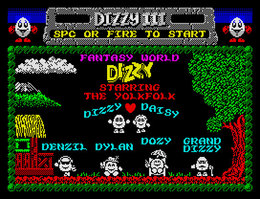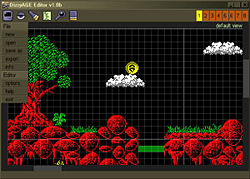Dizzy (series)
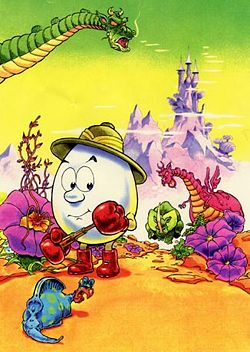
According to the Oliver Twins, "this was the first illustration to really capture the spirit behind Dizzy. It's the box artwork by Alastair Graham for Fantasy World Dizzy."[1]
Dizzy is a series of video games initially created by the Oliver Twins and published by Codemasters between 1986 and 1993. With the exception of The Fantastic Adventures of Dizzy, they were only released in Europe, leaving the game relatively unheard of in America. All but one of the games were originally created for the Amstrad CPC and ZX Spectrum, but most of the games were quickly ported over to other systems including the Commodore 64, Atari ST and Amiga. Some of the later games were also released for the NES, Game Gear, Mega Drive and DOS.
There are two main types of Dizzy game. The first type, which include the first two games released, are platform-adventure games. These are considered to be the main or core games in the series. In addition a number of small action games were released between the main games. These are generally considered spin-offs.
Recurring characters
The Yolkfolk
With a few exceptions, the cast of 'good guys' in the Dizzy series consists mainly of Dizzy and his family, collectively known as 'The Yolkfolk'. Each of these characters are eggs that wear boxing gloves, and are all visually similar except for one or two minor differences.
The only playable character in each of the Dizzy games is an egg known as Dizzy, however he was not intended to be an egg when created. The Oliver Twins felt that due to the graphical limitations at the time it was hard to identify with most video game characters, and they decided that the best way to counteract this was to focus on the most personable part of the character - the face.
One morning we were just playing around with how big we could get a face on screen, but that obviously meant not giving it a body. We ended up drawing the biggest face we could and simply added arms and legs to it so it actually held together and you could run it around the screen. — Philip Oliver, interview with Gamestation magazine[2]
An advantage of this was that the simply character was easy to animate, and the character was given a bounce when he stood and a somersault when he jumped. This inspired the name, Dizzy, and when people played the first game many of them immediately saw Dizzy to be an egg, and the Oliver Twins decided to run with this concept.
Dizzy was given red gloves (later decided to be boxing gloves) and red shoes. He has no other identifiable features. Due to his exploits he is often seen as the hero of the village.
Most of the rest of the Yolkfolk were introduced in Fantasy World Dizzy. Of these, the most significant is Daisy. Daisy is Dizzy's girlfriend. She is kidnapped or otherwise in peril several times throughout the series, and the goal of several games is to rescue her. She can be identified by her hair.
The other Yolkfolk introduced in Fantasy World Dizzy are:
- Dylan, a hippie, who is implied to be interested in certain illegal substances which often result in him entering a trance-like state. He can be identified by his hat.
- Denzil, the 'cool' member of the Yolkfolk, is never found far from his music and often cannot be bothered to talk to the others. He can be identified by his headphones and shades.
- Dozy, who is interested in almost nothing except sleep - often to the point that he cannot be woken. He has no physical identifying features, but can be identified by the ZZZZ's floating from his head signifying his snoring.
- Grand Dizzy, the elder of the Yolkfolk, is Dizzy's grandfather. He likes nothing more than telling everyone about tales of his youth, and doesn't seem to notice when nobody is around to listen to him. In Fantasy World Dizzy he can be identified by his walking stick and moustache, but in later games the moustache was replaced with a beard.
There were also two late additions to the Yolkfolk. First seen in Magicland Dizzy, Dora is Dizzy's younger sister, who can be identified by the bow in her hair. The other late addition is Danny, who never actually appeared in a published game. Prior to the release of Magicland Dizzy a mini-game called Dizzy 3.5: Into Magicland was released on the cover of some UK magazines, which was like the main games but consisted of only five screens and was only for promotional purposes. Danny was in this mini-game, and could be identified by his unusual posture.
The Good Wizard Theodore
Pogie the Fluffle
The Evil Wizard Zaks
Platform-adventure games
Gameplay
Whilst there are several differences between the platform-adventure games in the Dizzy series, the basic principles remain the same with just a few exceptions. The player controls the character Dizzy and can move him left and right. Dizzy is able to jump, but he does a somersault as he jumps. When jumping along a flat surface Dizzy will do a full somersault and land on his feet, but when jumping to a higher or lower surface he sometimes lands with his feet in the air and when this occurs Dizzy will roll until he regains his footing. This can sometimes cause frustration as the player may have needed to do a precision jump, however the roll may cause Dizzy to fall off the thing they were trying to jump onto or sometimes roll into a hazard.
Most of the games contain hazards that will injure Dizzy. The most common hazards are fire, water and animals, but there are others in some games including apples falling from trees, spikes and falling rocks. Dizzy cannot usually survive in water and when he falls into water he floats upside down and loses a life. However, some of the games provide items which allow Dizzy to breath underwater, and in some cases 'swim'. In the majority of games anything hazardous wass instantly fatal however, with the exception of Treasure Island Dizzy, Dizzy has multiple lives allowing the player to make a mistake without having to restart the game. Should Dizzy run out of lives the player must start the game from the beginning, as there are no 'continues' or 'save games'.
Most of the gameplay concerned usage of items. Dizzy was able to carry one or several items depending on the game, and these items could be used to solve puzzles. Some of these puzzles were simple common sense, such as using a key to open a door. Some of them derived from common children's stories or fairy tales. One such puzzle required the player to know that if a Prince kisses a person who has been turned into a frog they will turn back into their original form, a common theme in fairy tales. Another required the player to know that a potion labelled 'drink me' would shrink you whereas a cake labelled 'eat me' would make you big, something taken from Lewis Carroll's Alice in Wonderland.
One other recurring theme was the optional collection side-quest present in most of the games. Beginning in Treasure Island Dizzy there was usually an item that would be found in a certain number of places, usually thirty, spread throughout the game. These items - which could be coins, diamonds or other objects depending on the game - were not stored in the typical inventory system, but instead a tally was kept separately. Usually it was possible to reach an ending of sorts without collecting these items, but the player would then be given some reason to go and find every one. Only by finding them all could the player see the true ending. Whilst some of the items were easy to find and in plain sight, some of them items were more difficult as they would be found behind otherwise useless items that made up part of the scenery. Only by moving these items could the player discover the collectable item underneath. In some cases players found the collection part of the game harder than the rest of it.
Dizzy: The Ultimate Cartoon Adventure
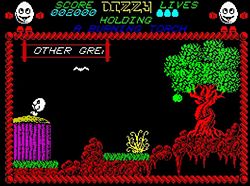
There were many hazards to avoid in the original game, including the bird and the apple shown here.
Dizzy was exploring a haunted forest when he found an ancient inscription in a stone slab titled "The Avawiffovee Potion", known through legend as the only way to get rid of two things - athletes foot and the Evil Wizard Zaks. With Zaks terrorising Dizzy's home village, Dizzy knew that if he could make the potion and destroy the wizard then he would be a hero. The slab gave the instructions for creating the potion, just "fill a potion bottle with cooked Leprechauns wig, cloud silver lining, Vampire dux feather and some troll brew - cook the potion and throw it at Zaks to dissolve his reign."[3] Covering up the slab once more, Dizzy set off to collect the ingredients and liberate the land of Katmandu.
Dizzy: The Ultimate Cartoon Adventure was created by the Oliver Twins and released in June 1986. Due to the technical limitations of computer systems at the time the graphics are quite poor in comparison to the rest of the series and use only four colours. However for the time these were excellent, and the game was described by critics as having "very good cartoon-type graphics with plenty of colour"[4].
This game was a lot more action-oriented than later games in the main series. Hazards that could kill Dizzy were many, ranging from spiders and bats to raindrops and apples. Unlike most of the hazards from later games in the series, some of these hazards could be 'killed'. Birds could be defeated using ACME bird seed, raindrops could be defeated using a rain coat and apples falling from trees could be defeated using a hard hat.
Dizzy began the game with three lives, but unlike in other games he could gain extra lives by collecting small flashing eggs. The more complex inventory systems of later games had not yet been developed, and Dizzy could only carry one item at a time. This required a lot of forward planning in, or back-tracking, in order to get the correct items to the right place.
Treasure Island Dizzy
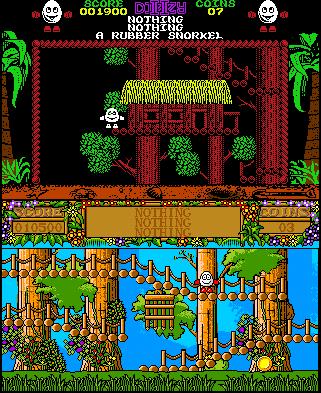
The graphical capabilities of computers at the time varied significantly, so the visual representation of the games differed drastically between systems. Here you can see the difference between the Commodore 64 version of Treasure Island Dizzy at the top, and the Amiga version of the same game at the bottom.
Dizzy was enjoying a round-the-world cruise that he had booked and paid for, even though the ship was run by pirates. He was having a good time when one afternoon Dizzy decided to organise a game of cricket on the aft deck. Stupidly he decided to use the Captain's spare wooden leg collection as the stumps, and when they were lost overboard the Captain forced Dizzy to walk the plank! Stranded on a deserted island, Dizzy had to find his way back to the village and lodge his compensation claim with the travel agent.
Treasure Island Dizzy was created by the Oliver Twins and released in August 1987. This was the first game to feature a collection side-quest, which required Dizzy to collect 30 gold coins in order to see the proper ending.
One of the biggest differences between Treasure Island Dizzy and all of the other main games is that Dizzy only had a single life. If the player made a mistake and died, they had to restart the game from the beginning. This made the game a lot more difficult than the rest of the series as there was no room to make mistakes. This was not a planned feature, and for most of the game design process Dizzy had three lives as in the original game. However, very late in the testing process a major flaw was found.
The one life was due to a logic bug. We found that if the player put down an object underwater or on the far beach it was extremely easy to drown poor old Dizzy. He'd be reset to the beach but be unable to get the snorkel or the items left on the far beach - making the game impossible to complete. We were under a huge amount of pressure to deliver the game so we ran out of time to solve that problem. It left us with only one option - we had to remove the other lives. — Philip Oliver, interview with Retro Gamer[5]
This was also the first Dizzy game to allow more than one item to be carried. Three items could be carried in the inventory, which was represented by a list at the top of the screen. The system was not very intuitive, however, and used a scrolling system. When the game was started each inventory slot was empty, and this was represented at the top of the screen as nothing, nothing, nothing on the three lines representing the inventory. When the player collected an item it the words would scroll up the screen, with the top 'nothing' vanishing as it moved out of the inventory area. The item that was picked up would scroll into the bottom slot. The inventory would now read nothing, nothing, an old solid chest. When the player next pressed the pick-up/drop button, the inventory would again scroll up. Nothing would actually be dropped as the top item was 'nothing', and the item at the bottom would move into the middle position. The button had to be pressed two more times in order to drop or use the item - once to move it to the top position, and once more to actually drop it.
There were a couple of disadvantages with this system. If the player only held one item but it was in the top slot, picking up a new item would simultaneously drop the old item despite having two empty slots in the inventory. Also, if the player was holding three items and wished to use the one in the bottom slot, they first had to drop the top two items in order to reach the item they desired to use. This was especially awkward in the underwater areas of the game, as Dizzy could not breath underwater unless he was holding the snorkel and if the snorkel was ever dropped whilst Dizzy was underwater then Dizzy would drown causing the game would be over. If the player was underwater wished to pick up an item but the snorkel was in the top slot they first had to move to dry land, drop the snorkel, pick it up again and return to the item they wished to collect.
The combination of a single life, an awkward inventory system and the ease of dying by accidentally dropping the snorkel whilst underwater lead many fans to believe that this is the hardest game in the series. Indeed, many fans who have completed every other game in the series have failed to complete this one.
Fantasy World Dizzy
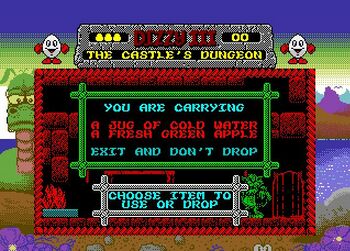
The inventory system introduced in Fantasy World Dizzy was carried on into most of the later games.
Dizzy was happily strolling through the enchanted forest with his girlfriend Daisy when suddenly the Evil King's trolls kidnapped them! Daisy was sent to Wizard Weird's Tallest Tower, whilst Dizzy was thrown deep into the King's dungeons! With only a green apple, a loaf of bread and a jug of water to help him, Dizzy must escape the dungeon and rescue Daisy.
Fantasy World Dizzy was created by the Oliver Twins and released in October 1989. As with most of the games in the series, Dizzy began the game with three lives. A collection sidequest was included, once again asking Dizzy to collect 30 coins.
The biggest change from the previous two games was the new inventory system. When Dizzy collected an item it was placed in his inventory which could hold two items at the beginning of the game, but increased to three after finding a way to expand it. To show that this has happened a dialog box appeared in the centre of the screen informing the player of the contents of the inventory. The player was then able to select any item in the inventory in order to drop or use it, or select "don't drop and exit" in order to close the inventory without dropping or using anything. This was a significant improvement to the awkward inventory system of Treasure Island Dizzy.
Magicland Dizzy
After making certain arrangements against his premature demise, the Evil Wizard Zaks returns to terrorize Dizzy and the Yolkfolk once again! In revenge for his destruction in Dizzy: The Ultimate Cartoon Adventure, Zaks has transported Dizzy and six of the Yolkfolk into a strange fairy tale world. In addition he has turned Dylan into a bush, frozen Denzil in a block of ice, put Dozy into a magical never-ending sleep, turned Dora into a frog, made Daisy grow to a much bigger size than normal, and trapped Grand Dizzy in a strange world behind Zaks' magical mirror. Dizzy must rescue each of these before destroying Zaks once again and finding a way home.
Magicland Dizzy was the first Dizzy game to not be designed by the Oliver Twins, although they retained design-approval oversight. The design was done in house at Codemasters by Neal Vincent, whilst the coding was contracted out to Big Red Software. The game was released in December 1990.
The game engine was was quite similar to the one used in Fantasy World Dizzy. Dizzy had three lives, could carry three items in the inventory that used the same menu system as the previous game, and there was also the now-standard collection quest requiring Dizzy to collect thirty diamonds. The newest addition to the system was the health bar. Whereas in previous games Dizzy would lose a life instantly upon coming into contact with a hazard, this time his health bar was instead reduced. Only when his health bar was reduced to zero would he lose a life. Only a few hazards, most notably water, were still instantly fatal. In addition, collecting a diamond gave Dizzy some of his health back, which lead to a potential advantage for those who did not collect every diamond they saw but instead left them for when they needed them.
Spellbound Dizzy
Spellbound Dizzy was created by Big Red Software and released in December 1990.
Fantastic Dizzy
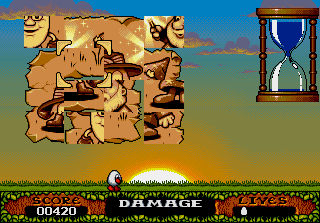
Action segments like the sliding puzzle stepped outside the usual boundaries for the main Dizzy games.
Fantastic Dizzy, released as The Fantastic Adventures of Dizzy outside of Europe and Australia, was created by the Oliver Twins. The game stands out as unusual compared to the other platform-adventure games in several ways. First of all, it was the only Dizzy game not released on the Spectrum or Amstrad CPC. Instead it was designed and coded exclusively for the higher-spec systems including the Amiga, Game Gear, Master System, Mega Drive (Genesis), NES and DOS. As a result it was never played by many fans of the series, as they could not get it on their usual system. Also, it was the only game released outside of Europe. Originally planned for release in December 1990, Codemasters found themselves in a legal battle and unable to keep the schedule. It was therefore released in April 1991, missing the Christmas rush and selling only a quarter of the 500,000 predicted units.
As it had been designed primarily for the faster-pace video consoles, Fantastic Dizzy was itself a lot more action-oriented than even the original game. Hazards to avoid were everywhere, but luckily the concept of a health bar had been carried over from Magicland Dizzy which could be restored by collecting food scattered around the world. The collection side-quest concept had also been carried in from previous games, but it was implemented slightly differently. Dizzy had to collect silver stars, however they weren't hidden behind scenery as in other Dizzy games. Instead they were everywhere and in fact there were a total of two hundred and fifty of them to collect, a significant increase from the usual thirty.
Whilst Fantastic Dizzy featured a number of puzzles unique to the game, a significant number were taken from previous games. For example at one point you discover that Dizzy's younger sister Dora has been turned into a frog, and the solution is to get her a kiss from a Prince which will turn her back into an egg. This exact same puzzle is found in Magicland Dizzy. As well as puzzles, the game featured a number of mini-games at various points in the game:
- A 4x4 sliding puzzle which had the squares mixed up and had to be rearranged within the time limit. Completing it granted the player an extra life.
- A mini-game version of Bubble Dizzy, which was also released standalone.
- A mini-game that was later released standalone as Dizzy Down the Rapids. This mini-game was not in all versions of the game.
- A mine carts ride similar to those found in other games. Dizzy rides a moving cart down a track, and at each junction must choose which direction to go. Some lead to dangers such as falling rocks, zombies and other carts, whilst others are clear.
- A crossbow shooting mini-game in which Dizzy must shoot at trolls who are occupying a castle.
The inventory system in this game took what some consider to be a step backwards, as it reverted to a system nearer to Treasure Island Dizzy. Three inventory slots were available, shown as three icons at the bottom of the screen. When an item was picked up it was put in the right-most slot that was empty. When you wanted to drop (or use) an item, you could only choose the item in the right-most slot. Once that item was dropped the items in the two other slots moved a space to the right, and the next item could be used. Therefore if the player was carrying three items and they wished to use the left-most one, they first had to drop the two other items.
Unusually for a Dizzy game Fantastic Dizzy features scrolling screens. When moving horizontally the screen scrolls so that Dizzy remains in the centre. However, vertical scrolling is not implemented and a new screen loads when Dizzy goes up or down a level.
Dizzy: Prince of the Yolkfolk
Dizzy: Prince of the Yolkfolk was created by Big Red Software and released in December 1991.
Crystal Kingdom Dizzy
Crystal Kingdom Dizzy was created by Visual Impact and released in December 1992.
Action games
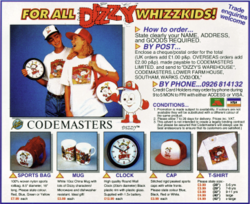
The Dizzy series became a huge success, leading to it's own range of merchandise.
Fast Food Dizzy
Fast Food Dizzy was created by the Oliver Twins and released in December 1987.
Kwik Snax
Kwik Snax was created by the Oliver Twins and released in November 1990.
Bubble Dizzy
Bubble Dizzy was created by the Oliver Twins and released in November 1990.
Dizzy Panic!
Dizzy Panic! was created by Big Red Software and released in May 1991.
Dizzy Down the Rapids
Dizzy Down the Rapids was created by the Oliver Twins and released in April 1991.
Go! Dizzy Go!
Go! Dizzy Go! was created by the Oliver Twins and released in November 1993.
The end of the official games
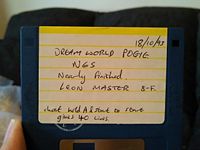
This disc was sent to yolkfolk.com by the Oliver Twins and contains a 'nearly finished' version of the cancelled Dreamworld Pogie.
After many years of collaboration between the Oliver Twins and Codemasters, Dizzy seemed to be reaching an end in terms of financial success as Prince of the Yolkfolk and Crystal Kingdom Dizzy had relatively poor sales in comparison to previous games. There are several reasons that have been attributed to this. One main reason is that Dizzy made it's name as a budget series of games. Most of the games were release for £2.00 (British pounds sterling), however Codemasters decided to try to release Crystal Kingdom Dizzy for £10.99. Another reason is that Codemasters wished to branch out from home computers into the upcoming video console line. Games for consoles tend to be quite action packed, yet Dizzy was a relatively slow game less suited to the console line.
Needing to work quickly to raise some funds the twins and their staff began work on several games including two platform-adventure games, Wonderland Dizzy and Dizzy the Adventurer (an enhanced version of Dizzy: Prince of the Yolkfolk), and two action games, Go! Dizzy Go! and Dreamworld Pogie. However, when several members of staff left and the Oliver Twins were unable to replace them, Dreamworld Pogie had to be cut. Work continued but Codemasters were not comfortable releasing the titles standalone at a time when they were financially struggling. With few options left the twins put together a compilation pack of the three games, but were then told by Codemaster's marketing department that they could not release two platform-adventure games in one compilation. With Dizzy the Adventurer at a further stage of development, they decided to drop Wonderland Dizzy and instead convert Panic Dizzy to replace it. The Excellent Dizzy Collection was finally released containing Panic Dizzy, Go! Dizzy Go! and Dizzy the Adventurer.
Shortly after this the Oliver Twins decided it was time to leave Codemasters and develop their own company Interactive Studios, now called Blitz Games Studios. However, whilst the Oliver Twins owned the copyright to Dizzy, Codemasters owned the trademark. This meant that future releases in the Dizzy series were impossible. In later years, after tensions between the two groups had cooled off, talks about resurrecting the Dizzy series commenced, but so far nothing has been agreed.
Fan-made games
With little chance of a new Dizzy game in the future, fans took it upon themselves to keep the series alive. In 2006 Alexandru Simion and Cristina Simion released the Dizzy Adventure Game Engine (DizzyAGE)[6] which is a free set of tools used to create Dizzy games in the classic adventure style that are playable on a Windows PC. Using this set of tools fans have been able to create over 45 games, including remakes of most of the original games.
Under copyright law these games could be considered breaches of intellectual property and at any point a cease and desist order could be issued to close down the entire system. The Oliver Twins have publicly stated that they will not prevent the release of these games as long as they use specific license text, although their company has made it clear that this was neither official or legally binding. Codemasters, who still own the trademark, have made no comment.
References
- ↑ http://www.olivertwins.com/yolkfolk.htm - Dizzy And The Yolkfolk..., The Oliver Twins
- ↑ http://www.yolkfolk.com/site/image.php?image=gamestm/gamemag3.jpg - The original good egg, Gamestation magazine
- ↑ Dizzy: The Ultimate Cartoon Adventure instruction manual
- ↑ http://www.yolkfolk.com/site/image.php?image=magazines/Crash4600134.jpg - Dizzy review, CRASH magazine, November 1987.
- ↑ http://www.yolkfolk.com/site/images/magazines/RetroGamer_TIDArticle_Page1.JPG - The Making of Treasure Island Dizzy, Retro Gamer
- ↑ http://yolkfolk.com/dizzyage/about.html - About DizzyAGE
